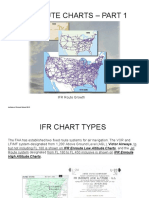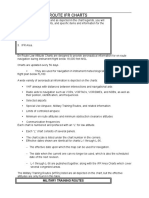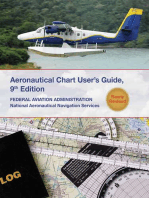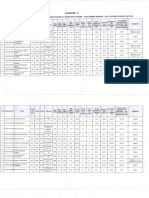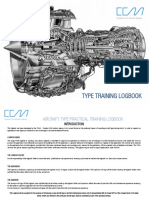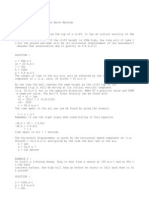0 ratings0% found this document useful (0 votes)
162 viewsExplanation of TPP Terms and Symbols: Pilot Briefing Information Planview
Explanation of TPP Terms and Symbols: Pilot Briefing Information Planview
Uploaded by
Reddy SaiThis document provides explanations of terms and symbols used in the Terminal Procedures Publication (TPP). It discusses elements like the pilot briefing information at the top of charts, planview depictions including terrain, and missed approach icons. It also covers RNAV minima standards and notes that GLS minima lines will be removed when LPV minima are published. Terminal Arrival Areas that provide efficient routing into terminals for aircraft with FMS/GPS equipment are also overviewed.
Copyright:
Attribution Non-Commercial (BY-NC)
Available Formats
Download as PDF, TXT or read online from Scribd
Explanation of TPP Terms and Symbols: Pilot Briefing Information Planview
Explanation of TPP Terms and Symbols: Pilot Briefing Information Planview
Uploaded by
Reddy Sai0 ratings0% found this document useful (0 votes)
162 views5 pagesThis document provides explanations of terms and symbols used in the Terminal Procedures Publication (TPP). It discusses elements like the pilot briefing information at the top of charts, planview depictions including terrain, and missed approach icons. It also covers RNAV minima standards and notes that GLS minima lines will be removed when LPV minima are published. Terminal Arrival Areas that provide efficient routing into terminals for aircraft with FMS/GPS equipment are also overviewed.
Original Title
2 ifr
Copyright
© Attribution Non-Commercial (BY-NC)
Available Formats
PDF, TXT or read online from Scribd
Share this document
Did you find this document useful?
Is this content inappropriate?
This document provides explanations of terms and symbols used in the Terminal Procedures Publication (TPP). It discusses elements like the pilot briefing information at the top of charts, planview depictions including terrain, and missed approach icons. It also covers RNAV minima standards and notes that GLS minima lines will be removed when LPV minima are published. Terminal Arrival Areas that provide efficient routing into terminals for aircraft with FMS/GPS equipment are also overviewed.
Copyright:
Attribution Non-Commercial (BY-NC)
Available Formats
Download as PDF, TXT or read online from Scribd
Download as pdf or txt
0 ratings0% found this document useful (0 votes)
162 views5 pagesExplanation of TPP Terms and Symbols: Pilot Briefing Information Planview
Explanation of TPP Terms and Symbols: Pilot Briefing Information Planview
Uploaded by
Reddy SaiThis document provides explanations of terms and symbols used in the Terminal Procedures Publication (TPP). It discusses elements like the pilot briefing information at the top of charts, planview depictions including terrain, and missed approach icons. It also covers RNAV minima standards and notes that GLS minima lines will be removed when LPV minima are published. Terminal Arrival Areas that provide efficient routing into terminals for aircraft with FMS/GPS equipment are also overviewed.
Copyright:
Attribution Non-Commercial (BY-NC)
Available Formats
Download as PDF, TXT or read online from Scribd
Download as pdf or txt
You are on page 1of 5
U.S.
TERMINAL PROCEDURES PUBLICATION 52
EXPLANATION OF TPP TERMS AND SYMBOLS
The discussions and examples in this section will be based primarily on the IFR (Instrument Flight Rule) Ter-
minal Procedures Publication (TPP). Other IFR products use similar symbols in various colors (see Section 2 of this
guide). The publication legends list aeronautical symbols with a brief description of what each symbol depicts. This
section will provide a more detailed discussion of some of the symbols and how they are used on TPP charts.
NACO charts are prepared in accordance with specifications of the Interagency Air Cartographic Committee
(IACC), which are approved by representatives of the Federal Aviation Administration, and the Department of
Defense. Some information on these charts may only apply to military pilots.
PILOT BRIEFING INFORMATION PLANVIEW
The pilot briefing information format consists of The majority of instrument flight procedure charts
three horizontal rows of boxed procedure-specific infor- contain a reference or distance circle. In such cases only
mation along the top edge of the chart. Altitudes, fre- the data within the reference circle is drawn to scale. This
circle is centered on an approach fix and normally has a
radius of 10 NM, unless otherwise indicated. When a
route segment, outside the circle, is not to scale the
W
symbol interrupts the segment.
Obstacles close-in to the airport that can not be
properly depicted in the planview are shown on the air-
quencies and channel, course and elevation values port sketch. Some of these obstacles could be control-
(except HATs and HAAs) are charted in bold type. The ling obsructions for instrument procedures.
top row contains the primary procedure navigation infor-
mation, final approach course, landing distance avail- Terrain Depiction
able, touchdown zone and airport elevations. The Terrain will be depicted in the planview portion of
middle row contains procedure notes and limitations, all IAPs at airports that meet the following criteria:
icons indicating if nonstandard alternate and/or take-off – If the terrain within the planview exceeds 4,000
minimums apply, approach lighting symbology, and the feet above the airport elevation, or
full text description of the missed approach procedure.
– If the terrain within a 6.0 nautical mile radius of
The bottom row contains air to ground communication
the Airport Reference Point (ARP) rises to at least 2,000
facilities and frequencies in the order in which they are
feet above the airport elevation.
used during an approach with the tower frequency box
bolded. Approximately 240 airports throughout the US
currently meet the above criteria.
NOTE: The W symbol indicates that outages of the The initial contour
WAAS vertical guidance may occur daily at this loca- value (lowest elevation) will
tion due to initial system limitations. WAAS NOTAMs be at least 500’ but no
for vertical outages are not provided for this approach. more than 1000’ above the
Use LNAV minima for flight planning at these locations, airport elevation. The initial
whether as a destination or alternate. For flight opera- contour value may be less
tions at these locations, when the WAAS avionics indi- than 500’ above the airport
cate that LNAV/VNAV or LPV service is available, then e l e v a t i o n i f n e e d e d t o NOT
NOT FO
FOR
O NAVI
VIIIG
VIG
IGATIO
AT
TIO
ON
N
vertical guidance may be used to complete the depict a rise in terrain close
approach using the displayed level of service. Should to the runway end. The
an outage occur during the procedure, reversion to n e x t c o n t o u r v a l u e
LNAV minima may be required. As the WAAS cover- depicted will be at a 1000’
increment (e.g., 1000’/
age is expanded, the W will be removed. 2000’/3000’, etc., NOT
1500’/2500’/3500’, etc.).
Subsequent contour inter-
vals will be constant and at
the most suitable intervals,
1000’ or 2000’, to adequately depict the rising terrain.
53 U.S. TERMINAL PROCEDURES PUBLICATION
MISSED APPROACH ICONS or when below the minimum published temperature,
In addition to the e.g., Baro-VNAV NA below -17˚ C (2˚ F).
full text description of the 2. DME/DME based RNP-0.3 systems may be
missed approach proce- used only when a chart note indicates DME/DME avail-
dure contained in the notes ability; e.g., “DME/DME RNP-0.3 Authorized.” Specific
section of the middle-briefing strip, the steps are also DME facilities may be required; e.g., “DME/DME RNP-
charted as boxed icons in the chart profile view. These 0.3 Authorized, ABC, XYZ required.”
icons provide simple-to-interpret instructions, such as
direction of initial turn, next heading and/or course, next LNAV (Lateral Navigation)
altitude, etc. Must have IFR approach approved GPS, WAAS,
or RNP-0.3 system. Other RNAV systems require special
RNAV CHART MINIMA approval.
RNAV instrument approach procedure charts will
now incorporate all types of approaches using Area Nav- NOTE: DME/DME RNP-0.3 systems may be used
igation systems, both ground based and satellite based. only when a chart note indicates DME/DME availabil-
Below is an explanation of the RNAV minima. ity; e.g., "DME/DME RNP-0.3 Authorized." Specific
The standard format for RNAV minima (and land- DME facilities may be required; e.g., "DME/DME RNP-
ing minima) is as shown below. RNAV minima are 0.3 Authorized. ABC, XYZ required."
TERMINAL ARRIVAL AREAS (TAAs)
296 300
The objective of the Terminal Arrival Area (TAA) is
to provide a seamless transition from the enroute struc-
ture to the terminal environment for arriving aircraft
equipped with Flight Management System (FMS) and/or
Global Positioning System (GPS) navigational equip-
dependent on navigational equipment capability, as ment. The underlying instrument approach procedure is
stated in the applicable AFM or AFMS, or other FAA an area navigation (RNAV) procedure. The TAA contains
approved document, and as outlined below. within it a “T” structure that normally provides for a No
Procedure Turn (NoPT) for aircraft using the approach.
GLS (Global Navigation Satellite System (GNSS) The TAA provides the pilot and air traffic controller with a
Landing System) very efficient method for routing traffic into the terminal
The GLS (NA) Minima line will be removed from environment with little required air traffic control interface,
the existing RNAV (GPS) approach charts when LPV and with minimum altitudes depicted that provide stan-
minima is published. dard obstacle clearance compatible with the instrument
procedure associated with it. The TAA will not be found
LPV (An Approach Procedure with Vertical Guid- on all RNAV procedures, particularly in areas of heavy
ance (APV) and precise lateral based on WAAS concentration of air traffic. When the TAA is published, it
replaces the MSA for that approach procedure. TAAs
Must have WAAS (Wide Area Augmentation Sys-
may appear on current and new format GPS and RNAV
tem) avionics approved for LPV approach.
IAP charts.
LNAV/VNAV (Lateral Navigation/Vertical Naviga- The standard TAA consists of three areas defined
tion) by the extension of the Initial Approach Fix (IAF) legs and
the intermediate segment course. These areas are called
Must have either:
the straight-in, left-base, and the right-base areas. TAA
a.) WAAS avionics approved for LNAV/VNAV area lateral boundaries are identified by magnetic
approach, or courses TO the IAF. The straight-in area can further be
b.) A certified Baro-VNAV system with an IFR divided into pie-shaped sectors with the boundaries
approach approved GPS, or identified by magnetic courses TO the IF/IAF, and many
c.) A certified Baro-VNAV system with an IFR contain stepdown sections defined by arcs based on
approach approved WAAS, or RNAV distances (DME or ATD) from the IF/IAF. The right/
left-base areas can only be subdivided using arcs based
d.) An approach certified RNP-0.3 system..
on RNAV distances from the IAF’s for those areas.
Other RNAV approach systems require special
approval. Straight-In Area: The straight-in area is defined by a
semi-circle with a 30 NM radius centered on and
NOTES: extending outward from the IF/IAF. The altitude shown
1. LNAV/VNAV minima not applicable for Baro- within the straight-in area icon provides minimum IFR
VNAV equipment if chart is annotated “Baro-VNAV NA” obstacle clearance
U.S. TERMINAL PROCEDURES PUBLICATION 54
Base Areas: the left and right base areas are bounded two engines - one-half statute mile. These standard min-
by the straight-in TAA and the extension of the inter- ima apply in the absence of any different minima listed in
mediate segment course. The base areas are defined Section C of the TPP.
by a 30 NM radius centered on the IAF on either side ALL USERS: Airports that have Departure Proce-
of the IF/IAF. The IF/IAF is shown in the base area dures (DPs) designed specifically to assist pilots in avoid-
icons without its name. The altitude shown within the ing obstacles during the climb to the minimum enroute
base area icons provides minimum IFR obstacle clear- altitude, and/or airports that have civil IFR take-off mini-
ance. mums other than standard, are listed in Section C of the
TPP by city. Take-off Minimums and Departure Proce-
dures apply to all runways unless otherwise specified.
Altitudes, unless otherwise indicated, are minimum alti-
tudes in MSL.
DPs specifically designed for obstacle avoidance
may be described in Section C of the TPP in text or pub-
lished as a graphic procedure. Its name will be listed, and
it can be found in either the TPPs (civil) or a separate
Departure Procedure volume (military), as appropriate.
Users will recognize graphic obstacle DPs by the word
“(OBSTACLE)” included in the procedure title; e.g.,
TETON TWO (OBSTACLE). If not assigned another DP or
radar vector by ATC, this procedure should be flown if
visual avoidance of terrain/obstacles cannot be main-
tained.
Graphic DPs designed by ATC to standardize
traffic flows, ensure aircraft separation and enhance
capacity are referred to as “Standard Instrument Depar-
tures (SIDs)”. SIDs also provide obstacle clearance and
are published under the appropriate airport section. ATC
Minimum MSL altitudes are charted within each clearance must be received prior to flying a SID.
of these defined/subdivisions that provide at least 1,000
feet of obstacle clearance, or more as necessary in NOTE: Graphic Departure Procedures that have been
mountainous ares designed primarily to assist Air Traffic Control in pro-
viding air traffic separation (as well as providing obsta-
NOTE: Additional information for the TAAs can be cle clearance) are usually assigned by name in an ATC
found in the Aeronautical Information Manual (AIM) clearance and are not listed by name in Section C of
Para 5-4-5-d. the TPP.
ALTERNATE MINIMUMS RNAV Departure Procedures (DP) and Standard
When an alternate airport is required, standard Terminal Arrival Routes (STAR)
IFR alternate minimums apply. Precision approach pro- RNAV DPs and STARs are being developed to
cedures require a 600’ ceiling and 2 statute miles visibil- support a more efficient traffic flow and further National
ity; nonprecision approaches require an 800’ ceiling and Airspace System (NAS) capacity. These procedures will
2 statute miles visibility. When a appears in the Notes be flown only by those aircraft with onboard databases.
section of the approach chart, it indicates non-standard These procedures will extend over a larger geographic
IFR alternate minimums exist for the airport. This infor- area to allow ATC spacing and sequencing to occur en
mation is found in Section E of the TPP. If appears, route. In order to reduce the number of pages required to
alternate minimums are not authorized due to unmoni- depict these longer procedures, changes to the graphic
tored facility or absence of weather reporting service. depictions and textual data are necessary.
Civil pilots see FAR 91.
NAVAID boxes will be removed and identified
Alternate Take-Off Minimums and (Obstacle) De- with only the name, the three-letter ident and the applica-
parture Procedures ble symbol. Waypoints will be identified with waypoint
symbol and five letter name. Waypoints that overlay
When a appears in the Notes section, it signi- NAVAIDs will be depicted only as NAVAIDs, not as a way-
fies the airport has nonstandard IFR takeoff minimums. point. A single graphic will be used when possible; how-
CIVIL USERS NOTE: FAR 91 prescribes standard ever, if not feasible, the common portion of the procedure
take-off rules and establishes take-off minimums for cer- will be shown on a single page with transitions contained
tain operators as follows: (1) Aircraft having two engines on subsequent pages. Subsequent pages will be subti-
or less - one statute mile. (2) Aircraft having more than tled with the transition area, i.e., CHEZZ ONE DEPAR-
55 U.S. TERMINAL PROCEDURES PUBLICATION
TURE Northeast Transitions, or JHAWK TWO ARRIVAL
South Transitions. Text remarks that apply to the entire
procedure, or all transitions, will be charted on the page
that contains the common point and common portion of
the procedure. Text remarks that apply to a specific tran-
sition will be charted on the page that contains that tran-
sition. Transition text will not include a description of the
route but will instead state expectations for altitudes,
clearances, FL restrictions, aircraft constraints, specific
airport arrival use, etc.
There are two types of RNAV SIDs and graphic
Obstacle DPs (ODPs): Type A and Type B. Type A gen-
erally starts with a heading or vector from the departure
runway end and Type B generally starts with an initial
RNAV leg near the departure runway end. Type A proce-
dures require the aircraft's track keeping accuracy
remain bounded by ± 2 NM for 95% of the total flight time
(Type B bounded by ± 1 NM ). See the AIM for more spe-
cific information.
RNAV Procedures Legs (IAPs, SIDs/DPs and
STARs)
Due to the variations in the development, docu-
mentation, charting and database coding of RNAV Pro-
cedures (IAPs, STARs SIDs/DPs), it has become
necessary to chart RNAV legs with specific information
based on their type. This data depiction will provide pilots
with a clearer indication of the type of leg the aircraft will
be flying and the ensuing flight profile.
– Heading - no waypoints shown, “hdg” charted
after degrees (i.e., 330˚ hdg), no mileage shown.
– Direct - waypoint at termination of leg, no
course shown, no mileage shown.
– Course - waypoint at termination of leg, course
shown, mileage shown only if first leg upon departure.
– Track - waypoints at beginning and termination
of leg, course shown, mileage shown.
Leg mileages will be listed differently based on
certain criteria. Mileages on Course and Track legs will be
shown to the nearest one-tenth of a NM when all three of
the following conditions are met:
Leg termination is 30 NM or less to the Airport
Reference Point (ARP) (for STARs, leg origination must
be 30 NM or less from the ARP for the primary airport)
and,
– leg segment is less than 30 NM and,
– leg segment is not part of the En route struc-
ture.
In all other instances, leg mileages will be
rounded off to the nearest whole NM, as they are cur-
rently.
U.S. TERMINAL PROCEDURES PUBLICATION 56
Instrument Approach Chart Format
{
Pilot Briefing
Information
NOT FOR NAVIGATION
N AV
VIGA
ATI
TIIO
ONN
Terminal Arrival
Areas (TAAs)
Missed
Approach
Icons
RNAV Minima
{
You might also like
- ATPL Core Theory Rev 1-1-4Document222 pagesATPL Core Theory Rev 1-1-4Yannis100% (3)
- Technical Interview WIZZ - PREPDocument51 pagesTechnical Interview WIZZ - PREPRicardoNo ratings yet
- 737 Performance Reference Handbook - EASA EditionFrom Everand737 Performance Reference Handbook - EASA EditionRating: 4.5 out of 5 stars4.5/5 (3)
- 175 1 InstructionsDocument6 pages175 1 Instructionskiowachen50% (2)
- Understanding Approach PlatesDocument16 pagesUnderstanding Approach PlatesAli Basmaci100% (2)
- How To Determine Transition LevelDocument5 pagesHow To Determine Transition Levelpilot digitalNo ratings yet
- B777 PDFDocument21 pagesB777 PDFLeo Chan100% (1)
- NCP Preeclampsia and EclampsiaDocument14 pagesNCP Preeclampsia and EclampsiaBiway RegalaNo ratings yet
- Lesson Plan Pob MarketingDocument6 pagesLesson Plan Pob Marketingapi-461137051No ratings yet
- Enroute Charts - Part 1: IFR Route GrowthDocument21 pagesEnroute Charts - Part 1: IFR Route GrowthFrederick OteikwuNo ratings yet
- Tutorial - How To Interpret An Approach Plate: 1. IntroducionDocument8 pagesTutorial - How To Interpret An Approach Plate: 1. IntroducionsivsorNo ratings yet
- Printing _Plan View_Document12 pagesPrinting _Plan View_doctors11No ratings yet
- TestDocument15 pagesTestVASILIKI ANNA FAKINo ratings yet
- Jeppesen Chart ClinicDocument2 pagesJeppesen Chart Clinickriki_m100% (2)
- Transition Altitude and Transition Flight LevelDocument4 pagesTransition Altitude and Transition Flight Levelpilot digitalNo ratings yet
- How To Read Approach PlatesDocument8 pagesHow To Read Approach PlatesKamran Shah100% (1)
- ECOMSDocument17 pagesECOMSKHA ZING WU LIANGNo ratings yet
- Understanding Approach PlatesDocument16 pagesUnderstanding Approach PlatesJerry LaviñaNo ratings yet
- Jeppesen - Chart GlossaryDocument216 pagesJeppesen - Chart GlossaryGabriel Ferreira100% (1)
- Jeppesen Airline Charts 2Document14 pagesJeppesen Airline Charts 2Raveena SharmaNo ratings yet
- AF2, Cartas Aeronauticas, Alfabeto AeronauticoDocument43 pagesAF2, Cartas Aeronauticas, Alfabeto AeronauticoJay ManNo ratings yet
- Pilot Manual AirwayDocument132 pagesPilot Manual AirwaySinazo100% (2)
- ATPL Oral NotesDocument8 pagesATPL Oral NotesTanishq VashisthNo ratings yet
- Jeppesen Airport Chart LegendDocument45 pagesJeppesen Airport Chart LegendRicardo Garcia100% (2)
- NAV N Radio ATPL Viva With AnswersDocument31 pagesNAV N Radio ATPL Viva With AnswersnodynarenNo ratings yet
- 737 Warning Systems NotesDocument12 pages737 Warning Systems NotesDanielNo ratings yet
- Airbus A320 Performance Notes Compress 3Document7 pagesAirbus A320 Performance Notes Compress 3amer abdelatiNo ratings yet
- Arrival ChartDocument77 pagesArrival ChartJeff Provido100% (2)
- Jar Ops Minimums On Jeppesen ChartsDocument10 pagesJar Ops Minimums On Jeppesen ChartsEce TuğrulözNo ratings yet
- Terminal Procedures PublicationDocument18 pagesTerminal Procedures PublicationAlejandro PattNo ratings yet
- Jeppesen Intro PDFDocument78 pagesJeppesen Intro PDFBAZOUKNo ratings yet
- Wrong QNH SettingDocument2 pagesWrong QNH SettingEric Daniel Dorado QuindeNo ratings yet
- NAV N Radio ATPL Viva With AnswersDocument34 pagesNAV N Radio ATPL Viva With AnswersShrikant PatilNo ratings yet
- In Flight Guide CJ3 Plus Edition 5Document35 pagesIn Flight Guide CJ3 Plus Edition 5AmandoNo ratings yet
- Caa Safety Sense Leaflet - For VFRDocument8 pagesCaa Safety Sense Leaflet - For VFRWill HardyNo ratings yet
- 8th IAP SymbolsDocument10 pages8th IAP SymbolsArasophyNo ratings yet
- Approach Chart - Heading: For Study Guide OnlyDocument191 pagesApproach Chart - Heading: For Study Guide OnlyPedroHeckNo ratings yet
- ATM Enroute IFR ChartsDocument28 pagesATM Enroute IFR ChartsNick Tsang100% (1)
- Inro To NabigationDocument11 pagesInro To NabigationIWIS AviationNo ratings yet
- ATPL Oral PreparationDocument7 pagesATPL Oral PreparationLuxury Thoda HatkeNo ratings yet
- Approaches: U.S. Terminal Procedures ChartDocument21 pagesApproaches: U.S. Terminal Procedures ChartNick TsangNo ratings yet
- Area Chart / Approach Chart GlossaryDocument14 pagesArea Chart / Approach Chart GlossaryAmirAli MohebbiNo ratings yet
- ADC Altimetry ATCDocument6 pagesADC Altimetry ATCWIN MINNo ratings yet
- Printing _Landing Minimums_Document7 pagesPrinting _Landing Minimums_doctors11No ratings yet
- Introduction to Jeppesen Navigation Charts 2011Document78 pagesIntroduction to Jeppesen Navigation Charts 2011John ArevaloNo ratings yet
- Intro To Enroute ChartsDocument46 pagesIntro To Enroute ChartsSyyed HasnainNo ratings yet
- Russia OpsDocument6 pagesRussia OpsGraham WaterfieldNo ratings yet
- Jeppesen LegendDocument11 pagesJeppesen LegendSanchit Singhal100% (1)
- Chapter 2-CDocument78 pagesChapter 2-CAxel RiveraNo ratings yet
- JAA ATPL Book 11 - Oxford Aviation - Jeppesen - Radio NavigationDocument394 pagesJAA ATPL Book 11 - Oxford Aviation - Jeppesen - Radio NavigationJacquie Jimenez75% (4)
- Takeoff Minimums, (Obstacle) Departure Procedures, and Diverse Vector Area (Radar Vectors)Document5 pagesTakeoff Minimums, (Obstacle) Departure Procedures, and Diverse Vector Area (Radar Vectors)Ty CrisosNo ratings yet
- Unit 4 Airport DesignDocument28 pagesUnit 4 Airport Designpriyangaraja5555No ratings yet
- Navigation EASA Part 66Document44 pagesNavigation EASA Part 66HussainAhmed100% (3)
- Introduction Legend EASA MinimumsDocument8 pagesIntroduction Legend EASA MinimumsEduardo AlmeidaNo ratings yet
- Ac 35-Barometric Vertical Navigation (Baro Vnav)Document6 pagesAc 35-Barometric Vertical Navigation (Baro Vnav)KINGDOEMSELYNo ratings yet
- Aeronautical Chart Users Guide: National Aeronautical Navigation ServicesFrom EverandAeronautical Chart Users Guide: National Aeronautical Navigation ServicesRating: 3 out of 5 stars3/5 (1)
- The Samora Machel and Helderberg Conspiracies and Other South African Air AccidentsFrom EverandThe Samora Machel and Helderberg Conspiracies and Other South African Air AccidentsNo ratings yet
- Blockbuster 1 Final TestDocument6 pagesBlockbuster 1 Final TestMaja HristovskaNo ratings yet
- CH15Document29 pagesCH15Hamza AlBulushiNo ratings yet
- Case Study Report (Peptic Ulcer) Group 1Document9 pagesCase Study Report (Peptic Ulcer) Group 1Khrizlynne SoberanoNo ratings yet
- Pediatric and Adolescent GynecologyDocument11 pagesPediatric and Adolescent GynecologyAndrea GuidoteNo ratings yet
- ECO401Document31 pagesECO401Ahmed nawazNo ratings yet
- Soal Toefl Read 3-DikonversiDocument32 pagesSoal Toefl Read 3-DikonversiLailareza ShintiaNo ratings yet
- Data Flow Diagram 3Document3 pagesData Flow Diagram 3Haco Chinedu ObasiNo ratings yet
- Team 6 Feature Package FinalDocument6 pagesTeam 6 Feature Package Finalapi-285915854No ratings yet
- Ebsd (Electron Backscattered Diffraction)Document45 pagesEbsd (Electron Backscattered Diffraction)mm11_nedNo ratings yet
- Financial Reporting, Planning, Performance and Control: Prepared By: Sameh.Y.El-lithy. CMA, CIADocument28 pagesFinancial Reporting, Planning, Performance and Control: Prepared By: Sameh.Y.El-lithy. CMA, CIAAhmed Mostafa ElmowafyNo ratings yet
- Hugo BossDocument64 pagesHugo BossEzgi Yıldız100% (1)
- PMP Math Prep Final Quiz Time Cost 1Document12 pagesPMP Math Prep Final Quiz Time Cost 1Mohamed Arbi Ben YounesNo ratings yet
- 5.1 Skill in SportDocument42 pages5.1 Skill in SportzzzzzzNo ratings yet
- ELLITE (English Language and Literature Enthusiasts) The Official Ctu Danao English ClubDocument9 pagesELLITE (English Language and Literature Enthusiasts) The Official Ctu Danao English ClubRenelyn Rodrigo SugarolNo ratings yet
- You're A Sitting Duck in A Gun-Free ZoneDocument1 pageYou're A Sitting Duck in A Gun-Free ZoneAmmoLand Shooting Sports NewsNo ratings yet
- Doga TestersDocument12 pagesDoga TestersihtishamuddNo ratings yet
- Nidhi Scheme': Annexure - F BC-BDocument5 pagesNidhi Scheme': Annexure - F BC-BVinay Kumar RaparthiNo ratings yet
- Lyrics For Bale by Niniola FeatDocument4 pagesLyrics For Bale by Niniola FeatBabajide AdedapoNo ratings yet
- Inca Social StructureDocument19 pagesInca Social StructureRebecca Hefter CarmonaNo ratings yet
- Wages and Other Monetary Benefits Important Questions On LLM CourseDocument10 pagesWages and Other Monetary Benefits Important Questions On LLM CourseAaditha Karikalan100% (1)
- Department of Business Administration: Rani Channamma UniversityDocument96 pagesDepartment of Business Administration: Rani Channamma Universitysriram tarunNo ratings yet
- Agrim Price List JulyDocument4 pagesAgrim Price List Julybackhoe loaderNo ratings yet
- 944 Type Training Logbook PDFDocument17 pages944 Type Training Logbook PDFTrần Triệu PhongNo ratings yet
- SpaceDocument3 pagesSpaceIrene BarbaraNo ratings yet
- Cat 2020Document10 pagesCat 2020sk atiar rahamanNo ratings yet
- Projectile QuestionsDocument4 pagesProjectile QuestionsNihal SinghNo ratings yet
- Inhalt /contentsDocument1 pageInhalt /contentsAvatar EngNo ratings yet
- Litary, Biographical, Linguistic and Socio-Cultural Context of Literary TextDocument17 pagesLitary, Biographical, Linguistic and Socio-Cultural Context of Literary TextAbegael PrimaNo ratings yet











